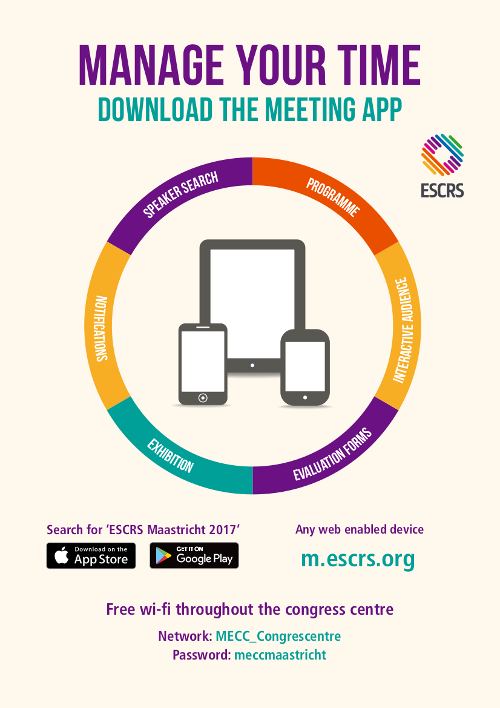Unexpected residual astigmatism occurrence and management after toric intraocular lens (IOL) implantation: a 3 years cohort study
(results will display both Free Papers & Poster)
Session Details
Session Title: Cataract
Session Date/Time: Saturday 11/02/2017 | 08:30-11:00
Paper Time: 09:12
Venue: Auditorium 1
First Author: V.Webers THE NETHERLANDS
Co Author(s): N. Visser N. Bauer I. Saelens H. Beckers C. Webers R. Nuijts
Abstract Details
Purpose:
To describe the incidence and management of unexpected high residual refractive astigmatism in a 3-year period at the University Eye Clinic Maastricht, Netherlands.
Setting:
All secondary treatments after toric IOL implantation performed at our institution (University Eye Clinic Maastricht) between June 2013 and June 2016 were included.
Methods:
A total of 310 eyes, undergoing toric IOL implantation, were retrospectively analyzed. In the majority of cases (>90%) an Acrysof SN6ATT tIOL-model (SN6AT3-SN6AT9) was implanted with the assistance of the VERION Image Guided System. K-readings obtained with the IOLMaster were transferred into a web-based first generation toric calculator (Acrysof Toric Calculator). Astigmatism axis orientation was with-the-rule (WTR) in 61% and against-the-rule (ATR) in 25% of cases. Vector analyses by Alpins was performed to measure the amount of unexpected residual refractive astigmatism. The Berdahl & Hardten Astigmatism Fix Calculator was used to determine if repositioning of the toric IOL was indicated.
Results:
Overcorrection of >1.00D compared to predicted residual refractive astigmatism was seen in 21 cases (11%) in the WTR-group compared to 2 cases (3%) in the ATR-group. Six out of 23 eyes (26%) with residual refractive astigmatism >1.0D desired secondary treatment. IOL-exchange and laser touch-up was required in respectively 4 (1% of total population) and 2 (1% of total population) cases. Misalignment of >10? was present in 15 cases (5%) and 7/15 cases (47%) underwent repositioning (2% of total population). After secondary treatment, all 13 eyes had residual refractive astigmatism of <0.5D and all patients were satisfied with their visual outcome.
Conclusions:
This study showed that toric IOLs are a safe and effective treatment option to correct pre-existent corneal astigmatism in patients undergoing cataract surgery. A general overcorrection was seen in WTR patients, which might be explained by the use of a first generation toric calculator neglecting the posterior corneal astigmatism. Up to a quarter of patients having overcorrection of >1.00D required secondary treatments. Misalignment of >10? was in nearly 50% of cases a reason for repositioning. After secondary treatment, all patients were satisfied with their visual outcome.
Financial Disclosure:
receives consulting fees, retainer, or contract payments from a company producing, developing or supplying the product or procedure presented, receives consulting fees, retainer, or contract payments from a competing company



